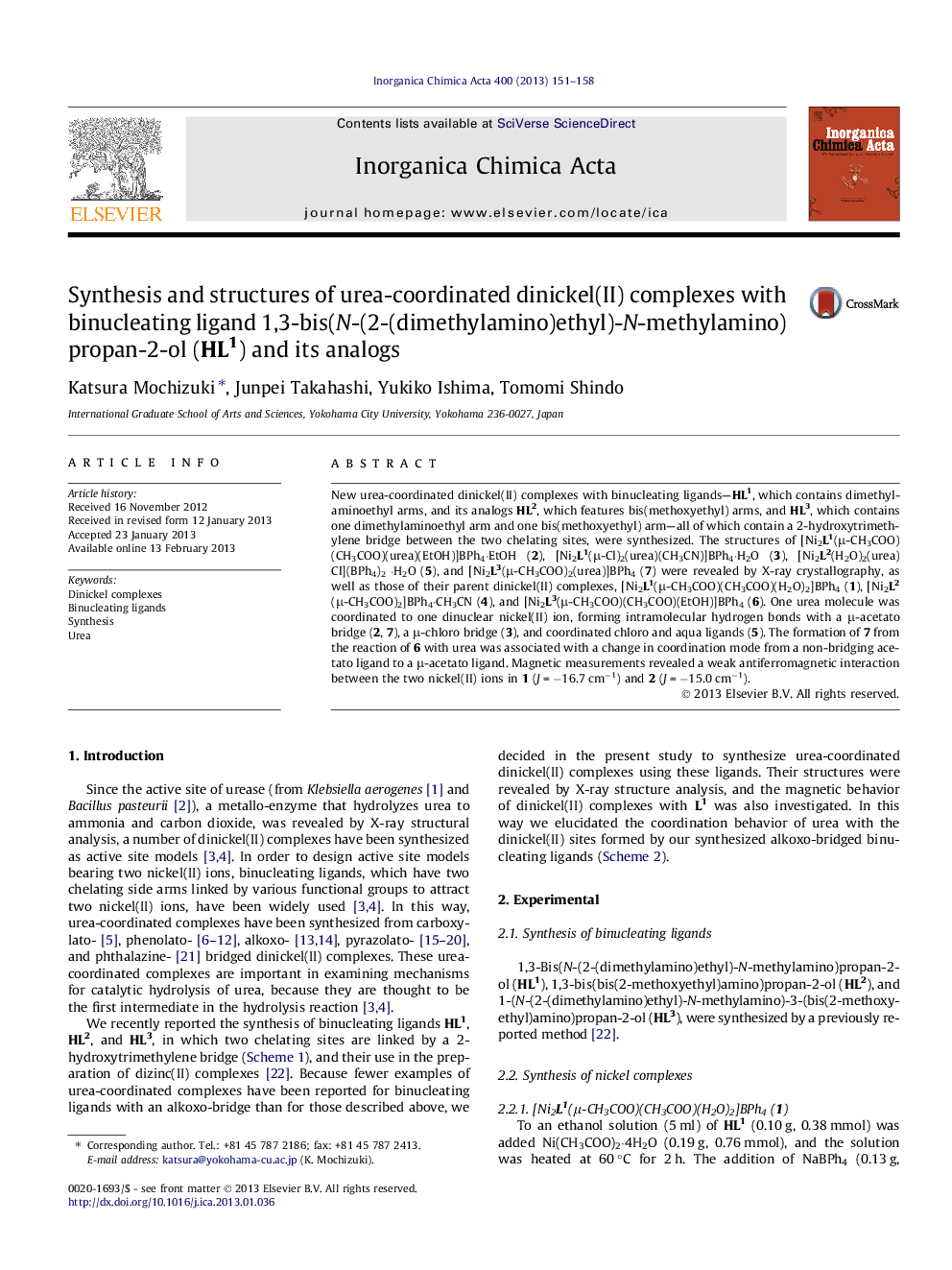| Article ID | Journal | Published Year | Pages | File Type |
|---|---|---|---|---|
| 1307111 | Inorganica Chimica Acta | 2013 | 8 Pages |
New urea-coordinated dinickel(II) complexes with binucleating ligands—HL1, which contains dimethylaminoethyl arms, and its analogs HL2, which features bis(methoxyethyl) arms, and HL3, which contains one dimethylaminoethyl arm and one bis(methoxyethyl) arm—all of which contain a 2-hydroxytrimethylene bridge between the two chelating sites, were synthesized. The structures of [Ni2L1(μ-CH3COO)(CH3COO)(urea)(EtOH)]BPh4·EtOH (2), [Ni2L1(μ-Cl)2(urea)(CH3CN)]BPh4·H2O (3), [Ni2L2(H2O)2(urea)Cl](BPh4)2·H2O (5), and [Ni2L3(μ-CH3COO)2(urea)]BPh4 (7) were revealed by X-ray crystallography, as well as those of their parent dinickel(II) complexes, [Ni2L1(μ-CH3COO)(CH3COO)(H2O)2]BPh4 (1), [Ni2L2(μ-CH3COO)2]BPh4·CH3CN (4), and [Ni2L3(μ-CH3COO)(CH3COO)(EtOH)]BPh4 (6). One urea molecule was coordinated to one dinuclear nickel(II) ion, forming intramolecular hydrogen bonds with a μ-acetato bridge (2, 7), a μ-chloro bridge (3), and coordinated chloro and aqua ligands (5). The formation of 7 from the reaction of 6 with urea was associated with a change in coordination mode from a non-bridging acetato ligand to a μ-acetato ligand. Magnetic measurements revealed a weak antiferromagnetic interaction between the two nickel(II) ions in 1 (J = −16.7 cm−1) and 2 (J = −15.0 cm−1).
Graphical abstractNew urea-coordinated dinickel(II) complexes with binucleating ligands (HL1, HL2, and HL3) were synthesized. The structures of [Ni2L1(μ-CH3COO)(CH3COO)(urea)(EtOH)]BPh4·EtOH (2), [Ni2L1(μ-Cl)2(urea)(CH3CN)]BPh4·H2O (3), [Ni2L2(H2O)2(urea)Cl](BPh4)2·H2O (5), and [Ni2L3(μ-CH3COO)2(urea)]BPh4 (7) were revealed by X-ray crystallography, as well as those of their parent dinickel(II) complexes, [Ni2L1(μ-CH3COO)(CH3COO)(H2O)2]BPh4 (1), [Ni2L2(μ-CH3COO)2]BPh4·CH3CN (4), and [Ni2L3(μ-CH3COO)(CH3COO)(EtOH)]BPh4 (6). Magnetic measurements revealed a weak antiferromagnetic interaction between the two nickel(II) ions in 1 (J = −16.7 cm−1) and 2 (J = −15.0 cm−1).Figure optionsDownload full-size imageDownload as PowerPoint slideHighlights► New urea-coordinated nickel(II) complexes with binucleating ligands were synthesized. ► Their structures were revealed by X-ray crystallography. ► One urea molecule is coordinated to one dinuclear nickel(II) ion. ► Hydrogen bonding is thought to play a significant role in the coordination of urea. ► A weak antiferromagnetic interaction acts between the two nickel(II) ions.
